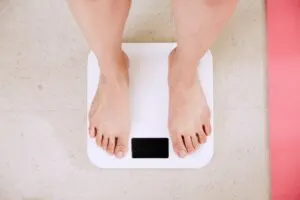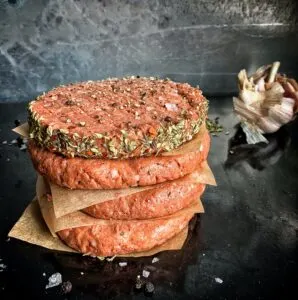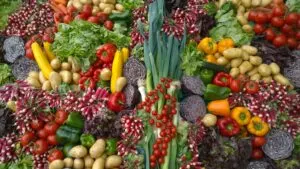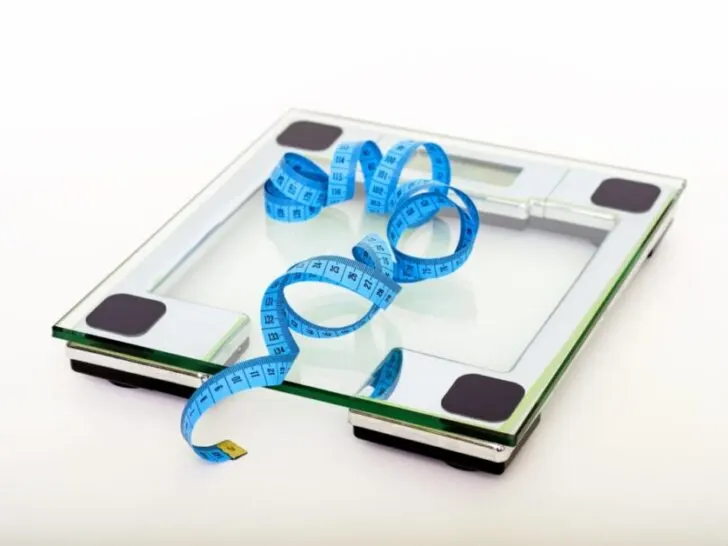Some of the links in this post are affiliate links. This means if you click on the link and purchase the item, we will receive an affiliate commission from the vendor at no extra cost to you. These business relationships allow us to keep bringing you great EatMoveHack content. All opinions remain our own.
If you got on your scale this morning, you most likely looked at your total body weight. Maybe you are aiming for weight loss or muscle mass gain, and therefore your body weight is one way to assess your progress. But body composition is important too! We are going to look more into details at what it is, and how body composition is important for your fitness level and your entire body in general.
What is Body Composition?
 Your overall weight is one indicator of your fitness level and general health. In addition, there are other indicators that will help you better monitor your health. The major indicator is body composition (also referred to as body comp).
Your overall weight is one indicator of your fitness level and general health. In addition, there are other indicators that will help you better monitor your health. The major indicator is body composition (also referred to as body comp).
On a standard scale, you will obtain basic information about your weight. On a body composition scale, you will also get details about the components of it. The main ones are fat, lean body mass (muscles, bones, internal organs), and water. The proportion of those in your body depends on a lot upon factors such as gender, age, level of fitness, etc. If you are hoping to lose weight or increase muscle mass, then being able to monitor these is very helpful.
Having body fat is essential for our health, but if your food intake is worth more than the amount of energy you spend during your day, the body stores those extra calories as fat. Like anything in the body, too much fat is damageable for your health and can cause for example heart problems or high blood pressure. Body Mass Index (BMI) has been used as a way of knowing where you stand with body fat but is not super accurate as it is only a ratio between your height and your weight. As said above, your overall weight does not tell us much about your health or fitness level.
Lean body mass includes your muscles, internal organs, and bones. If you are using weight training as a way to increase your muscle mass, you should eventually see an increase in your total body weight, which is why body composition is important: you can determine if you are adding weight because of muscle mass or body fat.
Finally, water is the last component of your body composition and a major one with that: over half of the body is water. Depending on the activity, climate, and more, you need to replenish what you lose every day through urine, sweat, and breathing. A recommended minimum is 2 liters per day, but if you are working out you might need more to ensure hydration and healthy body functions.
How Can You Measure Body Composition?
 First, let’s look at some guidelines for body fat ratio:
First, let’s look at some guidelines for body fat ratio:
| Men | Women | |
| Athletes | 6 to 13% | 14 to 20% |
| Fitness | 14 to 17% | 21 to 24% |
| Acceptable | 18 to 24% | 25 to 31% |
| Obese | 25% and over | 32% and over |
These are common measurements to use, but will obviously also depend on age, fitness level, and genetics so this might vary slightly.
In order to measure your body composition, there are a few instruments that you can look into:
Caliper: this simple tool is very inexpensive and is used simply by pinching your skin with it.
Body composition scale: a bit of an upgrade from your standard scale, this scale will give you not only your weight but also your body fat percentage and sometimes more. Some of these can even be linked to your phone with an app.
Handheld body fat analyzer: quite a bit more expensive than the previous option, it is as simple as holding it with your hands.
Note that none of these are perfectly reliable and factors such as hydration may change the results. If possible you want to take measurements at a regular time to help with reliability.
All these options are something you can do at home. You will also find that some more accurate medical options are available such as DEXA scanners or hydrostatic weighting but that requires going to a clinic or similar places and often that is not on the cheap side either.
Nutrition Facilitates Improvements in Body Comp
Now that we have looked at why body composition is important and how to track it, let’s look at how to work on it. There are two actionable parameters to your body composition: exercise and diet. Training plays a role in your muscle gain and your overall aspect, but nutrition is key to body composition and impacting your body fat percentage and body mass index.
 In order to help with body fat loss and/or muscle gain, depending on what your goal is, you need to fuel your body with foods that will give it the energy it needs to gain muscles and training.
In order to help with body fat loss and/or muscle gain, depending on what your goal is, you need to fuel your body with foods that will give it the energy it needs to gain muscles and training.
The main important food groups can be split as follow:
Proteins: these are key to muscle gain and recovery from your training. Proteins contribute to many functions in your body. You can find them in foods such as meats, eggs, dairy, fish.
Carbohydrates (often also called carbs): these are basically sugars and your body needs those for energy. However, there is a distinction between simple and complex carbs. Simple carbs are basically simple forms of sugar that you will find in cakes, sodas, and other sweet treats. Complex carbs on the other hand take longer to break down in your body, giving you a better source of energy. These would be foods like beans and grains, legumes, rice.
Fats: even if you are aiming at lowering your body fat percentage, your body needs fat for energy and various body functions. The key here is to fuel it with healthy fat foods, such as nuts, olive oil, avocado. You will also find fat in a lot of processed foods and these are the ones you want to stay away from, in meals such as fried food or junk food.
In order to function your body needs all of these. Ratios and types of foods are the keys here in order to have an impact on your body composition.
If you want to learn more about general healthy eating, check out our Eat page!
Which Foods Are Best
There are various diets out there that you can look into in order to improve body composition. Popular ones include the ketogenic diet, the slow carb diet, and more. If you are experimenting with them for the first time or are making strict changes in your diet, we recommend that you discuss making changes with a health professional in order to find what diet is good for you.
However, there are some basic principles that work for most people that you can apply to your diet in order to lower your body fat percentage and/or increase your muscle mass.
Stay away from processed foods: generally speaking, the less processed foods you eat the better. Why? Transformed foods are usually high in fats (and not the healthy ones!), sugars and salt. Not all of them are a bad choice, but you want to stay away from those with high amounts of sugars or transformed fats. Examples of these are breakfast cereals, cakes, and biscuits, ready meals, frozen baked foods.
There are a few tips to reduce the number of processed foods in your diet. First, stock your pantry with healthier snacks such as nuts or fruits. Second, try to organize to prep some meals ahead that you can store or freeze, so when you are short on time you are not tempted to order pizza!
 Vegetables are good for you: vegetables contain vitamins, minerals, and fibers amongst other things. All of these are necessary for your body to function properly. There are plenty of good reasons why you need those in your diet and they should be an important part of it. Eat your greens (and all other colors too)!
Vegetables are good for you: vegetables contain vitamins, minerals, and fibers amongst other things. All of these are necessary for your body to function properly. There are plenty of good reasons why you need those in your diet and they should be an important part of it. Eat your greens (and all other colors too)!
Water is also a “food”: hydration is key to our body functions. Water helps the body dispose of waste, keeps our temperature in check, and generally keeps organs functioning properly. As discussed before, our bodies are made of around 60% of water. Depending on the amount of exercise you do and the climate you are in, you will need to replenish your body with the water lost every day. A general rule for adults is to have 2 to 3 liters per day. This is not only done through drinking water but also other drinks like tea. A lot of foods are also rich in water like fruits (watermelon, strawberries, oranges) and vegetables (lettuce, cucumber, zucchini). That is another good reason to eat plenty of those!
Recommended Foods:
Now let’s have a look at each food group and see what should be on top of your shopping list for each of them:
Proteins: the easiest source of proteins is usually animal products such as eggs and lean meat. For vegetarians, tofu is also a good alternative. You will also get some proteins from grains and beans, as well as dairy products like yogurt or cheese.
Carbs: as discussed above, you want to stay clear from sugars as much as possible. Instead, you should rather get your carbs from complex sources. Grains and beans like green beans, chickpeas, quinoa, brown rice are great sources. Legumes like sweet potatoes are also a good source of carbs. Nuts will also provide carbs and they make for a great snack that you can carry around. Vegetables and fruits are also a good source of energy.
Healthy fats: for oil (dressing or cooking), virgin olive oil is your best bet. Most nuts are also a good source of fat, like almonds or cashews. Fatty fish is also packed with healthy fat, such as salmon or tuna. Cheese and dairy are also good and will also contain proteins. Finally avocado is also an excellent source of fat.
With all of these, you should have no problem having a variety in your diet and getting all the nutrients you need. Depending on your age and size as well as the amount of training you do, you will need to adjust quantities to get your metabolism what it needs. If your aim is muscle gain and lowering your body fat percentage while increasing muscle mass, have a look at our previous article about a nutrition plan for muscle gain.
Helpful Tips for Building Muscle
Now that we have looked at nutrition that can help with body composition, there are also other tips you can use in order to build muscle mass.
Supplements:
You will find on the market various smart drugs and supplements that will help with muscle growth. Some of the most popular ones include:
Whey protein: proteins are essential to building muscles. You can get plenty through your diet, but if you are working towards increasing muscle mass then you might want to look into giving your body a little boost. A popular way to supplement with proteins is to use whey protein before or after your workout. It is as easy as drinking a protein drink at those times. Here at EMH, we enjoy the following protein from Thorne.
Creatine: it is produced naturally by your body and helps with energy for muscles and various body tissues. Creatine helps with muscle strength and general performance. You can look into Thorne’s creatine option.
BCAA: branch-chained amino acids help with protein synthesis in your body, therefore reducing fatigue and muscle damage. It is therefore a favored supplement amongst athletes. It is easy to find it as a powder to be added to your drinks.
These are easy to use and can help with your goal of muscle growth. For our best biohacks to help with muscle growth, you can check our article here.
Now that you have a better understanding of body composition, you can get started on working towards your ideal body fat percentage!

